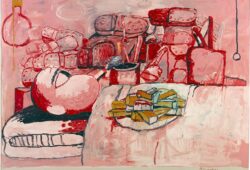The Enduring Legacy of Piet Mondrian’s Abstract Paintings
 Posted On
Posted On
Piet Mondrian, a Dutch artist, is renowned for his pioneering contributions to abstract art, particularly the development of the De Stijl movement. His distinctive geometric compositions, characterized by primary colors and straight lines, have left an indelible mark on the world of modern art. In this article, we will explore the life and works of Piet Mondrian, examining how his paintings continue to captivate and inspire art enthusiasts worldwide.
Early Life and Artistic Evolution
Piet Mondrian was born in 1872 in Amersfoort, Netherlands. His journey into the world of art began with Impressionism, as he explored naturalistic landscapes and traditional subjects. However, as the 20th century dawned, he underwent a profound artistic transformation. Mondrian embraced the radical shift towards abstraction, which aimed to distill art to its essence by eliminating non-essential elements.
The De Stijl Movement
Mondrian’s most iconic works emerged during his involvement with the De Stijl movement, a Dutch artistic and architectural movement founded in 1917. De Stijl, meaning “The Style” in Dutch, sought to create a universal visual language that reflected the spiritual and utopian aspirations of the era. Mondrian’s paintings became a cornerstone of this movement, characterized by a strict grid of horizontal and vertical lines, primary colors (red, blue, and yellow), and non-colors (black, white, and gray).
Composition and Harmony
Mondrian’s art was rooted in his belief that abstract elements like lines and colors could convey profound spiritual truths and harmony. His compositions were meticulously structured, creating a sense of balance and equilibrium. The intersections of lines and the arrangement of colors were carefully calculated to evoke a sense of order and serenity. This meticulous attention to balance and harmony is a hallmark of his work.
The Evolution of His Art
Over the years, Mondrian’s style evolved. His early works featured curvilinear lines and a broader color palette. However, as he delved deeper into abstraction, his compositions became increasingly simplified. By the 1920s, his paintings were characterized by straight lines, right angles, and a limited color palette. This evolution culminated in what is now considered his signature style, exemplified by works like “Composition with Red, Blue, and Yellow” (1930).
Global Influence
Mondrian’s influence extended far beyond the Netherlands. His art transcended borders, inspiring artists, architects, and designers worldwide. His vision of universal harmony resonated with the spirit of the age, and his geometric abstractions found their way into architecture, fashion, and graphic design. Notably, the Mondrian-inspired designs of the De Stijl movement influenced the Bauhaus and the International Style, shaping the modernist aesthetics of the 20th century.
Legacy and Enduring Relevance
Piet Mondrian passed away in 1944, leaving behind a remarkable artistic legacy. His paintings, often viewed as precursors to minimalism and abstract expressionism, continue to be celebrated and studied today. His exploration of the relationship between art, nature, and spirituality remains relevant, challenging viewers to contemplate the intersection of order and chaos, simplicity and complexity.
Piet Mondrian’s abstract paintings represent a radical departure from traditional art, embracing simplicity and abstraction to convey universal harmony and spirituality. His contributions to the De Stijl movement and modern art as a whole have left an indelible mark on the art world. His work endures as a testament to the power of abstract art to convey profound truths and inspire generations of artists.



